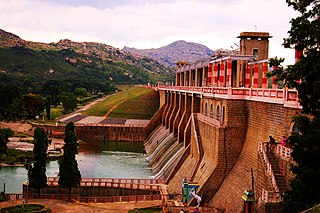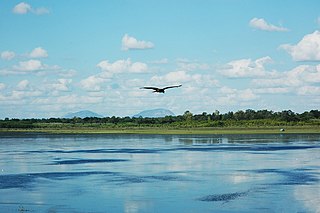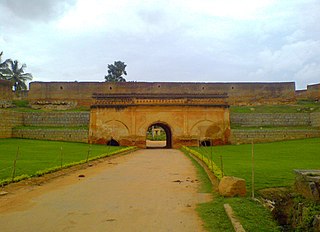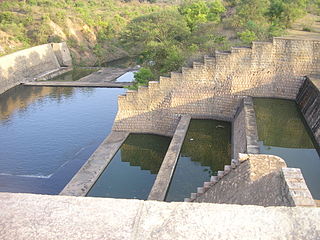
The South Pennar River is a river in India. Bangalore, Hosur, Tiruvannamalai, and Cuddalore are the important cities on the banks of South Pennar river. This is the second longest river in Tamil Nadu, with a length of 497 km, after the Kaveri. Chandapura, Anekal, Hosur, Bagalur and Chengam are the major industrial settlements on its banks. The river is severely polluted by industrial waste as it flows through major industrial areas in the eastern suburbs of Bangalore, Industrial parks of Hosur and Chengam.

Bangalore is the capital city of the state of Karnataka. Bangalore, as a city, was founded by Kempe Gowda I, who built a mud fort at the site in 1537. But the earliest evidence for the existence of a place called Bangalore dates back to c. 890.

Budikote or Budhikote is a village situated in Bangarapet taluk of Kolar district in the Indian state of Karnataka. It is located about 15 mi (24 km) from the district headquarters Kolar Gold Fields, the nearest city; Bangarpet the nearest town is 12 km (7.5 mi) away and Bangalore is 125 km (78 mi). It is a gram panchayat and covers an area of 355.65 ha. According to the 2011 census data, Budikote village has a population of 3,347—of which 1,743 are male and 1,604 are female—and a household count of 600.

Nandi Hills is an ancient hill station built by Ganga Dynasty in the Chikkaballapur district of Karnataka state. It is 10 km from Chickballapur town and approximately 60 km from Bengaluru. The hills are near the town Nandi. In traditional belief, the hills are the origin of the Arkavathy river, Ponnaiyar River, Palar River, Papagni River and Penna River. Watching the sunrise at Nandi Hills is popular with tourists. The first ever SAARC summit hosted by India was held at Nandi Hills in 1986.

Talakadu is a town on the left bank of the Kaveri river 45 km from Mysore and 133 km from Bangalore in Karnataka, India. Latinizations of the towns name vary, but include Talkād, Talakadu, Talakkadu, or Thalakadu. It had over 30 temples, most of which now lay buried in sand. The extant group of temples, where the eastward flowing Kaveri river changes course as the sand on its banks spreads over a wide area, is a popular pilgrimage site for Hindus.
Bangalore is situated in the southeast of the South Indian state of Karnataka. It is positioned at 12.97° N 77.56° E and covers an area of 2,190 square kilometres (850 sq mi). A landlocked city, Bangalore is located in the heart of the Mysore Plateau at an average elevation of 920 metres (3,020 ft). Bangalore district borders with Kolar and Chikkaballapur in the northeast, Tumkur in the northwest, and Mandya and Ramanagaram in the southeast.

Basavanagudi is a residential and commercial locality in the Indian city of Bangalore. It is located in South Bangalore, along the borders of Jayanagar. The name "Basavanagudi" refers to the Bull Temple, which contains a monolith statue of the Nandi Bull. The word Basava in Kannada means bull, and gudi means temple. Basavanagudi is one of the oldest and poshest areas of Bangalore. 4.6 km far from Bangalore City Railway Station and BMTC, and 38.7 km to Kempegowda International airport. The main commercial street of Basavanagudi is DVG Road, which is home to numerous retail businesses - several of them dating back to the 1920s and 1930s. Towards the middle of DVG Road is Gandhi Bazaar, known for its markets which sell fresh flowers, fruits, and vegetables. The neighbourhood includes several historic restaurants, notably Vidyarthi Bhavan, a vegetarian restaurant which was opened in 1943.

Thippagondanahalli Reservoir, also known as T G Halli Dam or Chamarajasagara, is located at the confluence of the Arkavathy and Kumudavathi rivers, 35 kilometres (22 mi) west of Bangalore, India. It is used by the Bangalore Water Supply and Sewerage Board as a major source of drinking water for western Bangalore. The lake is a man-made reservoir, created by the building of a dam which was inaugurated in 1933. M. Visvesvaraya supervised the construction work.

Kengeri is a suburb in Bangalore city. It is located on the western corridor along Mysore Road, bordered by Nagarbhavi to the north,Rajarajeshwari Nagar to the east and Uttarahalli to the south.

Malleshwaram is a northwest neighborhood and one of the zones of Bruhat Bengaluru Mahanagara Palike in Bengaluru, India. It was planned in 1889 after the great plague of 1898, developed as a suburb in 1892 and handed over to the city municipality in 1895. As per 1878 Survey of India map, the area came under the village of Ranganatha Palya and later was named after the Kadu Malleshwara Temple. The neighbourhood houses many offices one them being World Trade Center Bengaluru. It also has shopping malls Mantri Square and Orion Mall. Education boards of the state- KSEEB and PU boards - are located here.

Hesaraghatta Lake is a manmade reservoir located 18 km to the north-west of Bengaluru in Karnataka state, India. It is a fresh water lake created in the year 1894 across the Arkavathy River to meet the drinking water needs of the city. Sir K. Seshadri Iyer, the then Dewan of erstwhile Mysore state and the then Chief Engineer of Mysuru, M. C. Hutchins, planned to build the scheme called the "Chamarajendra Water Works" to store a three-years' water supply to the city.

Bugle Rock is a massive rock in the Basavanagudi area of South Bangalore, in the state of Karnataka. It is an abrupt rise above the ground of peninsular gneiss as the main rock formation and with an assessed age of about 3,000 million years. Bugle Rock has generated wide interest among the scientific community.

Devanahalli Fort is located 35 kilometers (22 mi) north of Bangalore city, at Devanahalli in the State of Karnataka, India. Chieftain Malla Byre Gowda of Avathi, a Vijayanagara empire vassal, built a mud fort in c. 1501 at Devanadoddi. In the late 18th century, Hyder Ali re-constructed the fort in stone resulting in the current structure.
Bangalore (Bengaluru), the capital of Karnataka state, India, reflects its multireligious and cosmopolitan character by its more than 1000 temples, 400 mosques, 100 churches, 40 Jain derasars, three Sikh gurdwaras, two Buddhist viharas and one Parsi fire temple located in an area of 741 km2 of the metropolis. The religious places are further represented to include the few members of the Jewish community who are making their presence known through the Chabad that they propose to establish in Bengaluru and the fairly large number of the Baháʼí Faith whose presence is registered with a society called the Baháʼí Centre. In the demographically diverse, major economic hub and India's fastest-growing major metropolis of Bengaluru, the number of religious places of each religion reported reflects growth in proportion to the population growth. According to the 2001 census of India, 79.37% of Bangalore's population is Hindu, roughly the same as the national average. Muslims comprise 13.37% of the population, which again is roughly the same as the national average, while Christians and Jains account for 5.79% and 1.05% of the population, respectively, double that of their national averages. Anglo-Indians also form a substantial group within the city.

The Arkavati is an important mountain river in Karnataka, India, originating at Nandi Hills of Chikkaballapura district. It is a tributary of the Kaveri, which it joins at 34 km south of Kanakapura, Ramanagara District called Sangama in Kannada, after flowing through Ramanagara and Kanakapura. The river drains into the Chikkarayappanahalli Lake near Kanivenarayanapura. Kumudavathi and Vrishabhavathi rivers are tributaries to this river. It forms Chunchi falls near Haroshivanahalli. It joins Cauvery river as a tributary near Mekedatu.
The Kadu Malleshwara Temple Kannada: ಕಾಡು ಮಲ್ಲೇಶ್ವರ is a 17th-century A.D. Hindu temple dedicated to the Shiva located in the Malleshwara locality of Bengaluru, Karnataka, India. The word 'Kadu' means forest, here referring to the thick greenery all around the temple.

Sri Dakshinamukha Nandi Tirtha Kalyani Kshetra is a small temple located in front of the Gangamma temple and diagonally opposite to the Kadu Malleshwara temple on 2nd Temple Street, Malleswaram layout in the north-western area of Bangalore city, Karnataka, India.

The following outline is provided as an overview of and topical guide to Karnataka:

Bangalore, officially Bengaluru, is the capital and largest city of the southern Indian state of Karnataka. It has a population of more than 8 million and a metropolitan population of around 11 million, making it the third most populous city and fifth most populous urban agglomeration in India, as well as second largest urban agglomeration in South India, and the 27th largest city in the world. Located on the Deccan Plateau, at a height of over 900 m (3,000 ft) above sea level, Bangalore has a pleasant climate throughout the year, with its parks and green spaces earning it the reputation as the "Garden City" of India. Its elevation is the highest among the major cities of India.
















